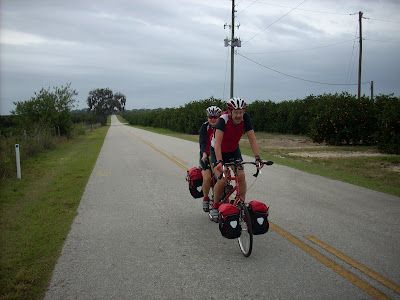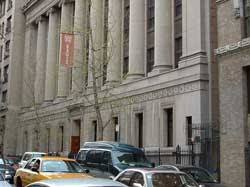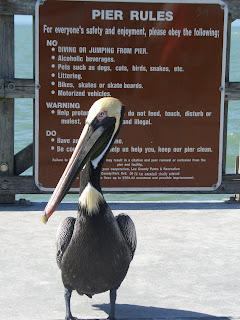After an easy ride through empty pine scrubland east of DeLand, we suddenly hit dense residential areas as we got within a few miles of I-95 and succeeded in finding roads with bike lanes or with bike-friendly sidewalks that got us through Daytona Beach to the ocean. Our arrival was carefully timed to miss the departing NASCAR crowd by one day and the start of "Bike Week" by one full week. Alas, NOT our kind of bikes.
And what a beach we found! As the highway approached the beach from the west, we expected the only options to be north or south, paralleling the beach. But the road continued to a toll booth, where cars can, for $5, drive right onto the beach! The sand is astonishingly compact, and in fact it was car racing on the beach almost a century ago that led to the creation of the Daytona 500.
Today you can race your car at any speed you like, so long as it is under 10 mph. You have to stay well inland of the water,
and get off every few miles for pedestrian only areas. In fact, few cars drove by us in the next 2 days of walking along the beach, and never bothered us.
Our stay was terrific, thanks to Paula and Mike,
next-door neighbors to us in a B&B 3weeks ago. They offered us use of their cottage 2 blocks from the beach, and it was perfect: cute, cozy and convenient. It's hard for us to get consistently healthy meals just from restaurants, and for 3 days we cooked the healthiest, best tasting suppers and breakfasts. We thank Paula and Mike profusely, and we are sure all our body parts thank them as well.
The beach was mesmeric, so much so that we ended up walking 25 miles in 2 full days off the bike -- so much for "rest days"! The surf, the shorebirds, pelicans gliding by in close formation like the Blue Angels in slow motion,
the endless stretch of hard-packed sand ... we just kept walking and walking, as if in a sand-induced trance.
On day two we reached a park with walkways through the sand dunes and a forested area to the lighthouse that marks the end of the peninsula. THIS was the beach experience we had come to Florida for!
Our 58-mile ride from Daytona Beach to St. Augustine was as easy as any ride of that distance we've done. There was a paved shoulder most of the way except in tony Ponte Vedra, where we took a local road that was narrow but fascinating as it went past beautiful house after beautiful oceanfront house. It had the added feature of a 25 mph speed limit which we almost hit, thanks to a light tailwind, but not a problem, the cars hardly passed us as they all seemed to obey the limit as well, despite their petrochemical-driven ability to exceed it more easily than we could.
St. Augustine was amazing. This place was 211 years old while Tom Jefferson was writing the Declaration of Independence! The reason for its founding is simple: the French had set up a fort near modern-day Jacksonville, which worried the Spanish king, and staffed it with French Protestants, which put the king in a frenzy. Add to this the fact that treasure ships headed to Spain with the wealth of the New World sailed just off the coast, and something had to be done. The town was founded in 1565 and almost disappeared the same year, as the French wasted no time in attacking. But the attackers were cut off by Spanish reinforcements from Havana, and that was the last of them. St. Augustine came close to extinction a few more times from fire, disease, and unfriendly Indians and Englishmen, but survived.
To our amazement, we discovered that Florida once had more missions than California, all of which closed when Florida was handed over to the British in 1763 as the result of Spain being on the losing side of the Seven Years War. If you click on the photo you can see the detail in this map, which shows only about one fourth of the missions the Spanish founded in and around Florida.
In the late 1600's the Spanish got serious about a fort to protect the place, and built Castello San Marco --
over a period of some 40 years. It was attacked 13 times, and it survived every one of them, including two lengthy sieges. During those sieges the entire population of 1300 people lived in the fort, and the accommodations were a tad tight. The sieges failed in part because of the
building material, coquina, a type of soft limestone with shell fragments that was said to "swallow" cannon balls lobbed into it, rather than smash apart. The detail here is of a portion of the original wall about the size of a modern brick.
To help bring history to life, the Park Service has found gunpowder-happy volunteers who dress up in army costumes of the 1600's to give a cannon-firing demonstration several times a day. It was a blast, as they say, despite the fact that the Park Service does draw the line at providing these pyrophiliacs with actual cannon balls.
The town can be expensive to walk through, with numerous places using "Historic" (sorta old), "Old" (a tad older), "Ancient" (getting REALLY old) or "Oldest" in their names to draw in the unwary tourist.
But for no cost at all you can walk through the old city gates (St. Augustine, like Quebec City, was once completely walled for protection) and down a pedestrian-only street where many ancient (sorry) buildings are and get
a fine feel for long-ago. You can also walk nearby to one of the less-well-known sights in town, the "Love Tree," where an oak tree has a palm tree in a woody embrace, to put a G-rated label on it.
We did surrender $12 for two tickets to tour a college. Now, that probably seems odd to a lot of you, as it did at first to us, but this is no ordinary college. Henry Flagler has been mentioned in the blog before -- he built the fabulous resort hotel The Breakers in Palm Beach, and he built Flagler's Folly, the railroad to Key West. His first foray into Florida however, armed with fabulous wealth earned as Rockefeller's partner in Standard Oil, was to St. Augustine. In 1888 he opened up the most expensive hotel built in America to that day, then called the Hotel Ponce de Leon, but home since 1969 to Flagler College, a 4-year liberal arts school. The hotel was designed by the architects who built the New York Public Library, and the glass and interior design was by Tiffany.
These pictures hopefully speak for themselves as to how beautiful this place still is. The hotel building is mainly used for its dining room and meeting rooms, with the original hotel rooms now housing female college students. Newer buildings nearby house classrooms and male students.
Is this not the most amazing college dining room you've ever seen? Small wonder we felt the tour price worth paying.
We're now in the upper right-hand corner of Florida, as it were -- Fernandina Beach. We had an easy day's ride to Atlantic Beach yesterday, with enough energy to walk 7 miles along yet another hard-packed beach where birds once again outnumbered the people, and an easier still time of it today riding a strong tail wind to Fernandina Beach as thunderstorms approached.
We arrived none too soon, and watched a good demonstration of angry weather all afternoon through the window of our hotel room. We'll close with this photo of the ferry that
brought us across the St. John's River today, and with two very different views from the road into Fernandina Beach. After a day playing on the beach tomorrow, we're off to Georgia. Talk to you next from there!





